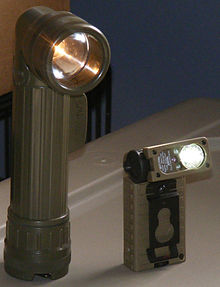
Back مشعل كهربائي Arabic টৰ্চ লাইট AS Əl fənəri AZ Фенерче Bulgarian টর্চলাইট Bengali/Bangla Llanterna elèctrica Catalan Vó'ho'êho'hóvahtôtse CHY Kapesní svítilna Czech Lommelygte Danish Taschenlampe German


A flashlight (US) or electric torch (CE), usually shortened to torch, is a portable hand-held electric lamp. Formerly, the light source typically was a miniature incandescent light bulb, but these have been displaced by light-emitting diodes (LEDs) since the early 2000s. A typical flashlight consists of the light source mounted in a reflector, a transparent cover (sometimes combined with a lens) to protect the light source and reflector, a battery, and a switch, all enclosed in a case.
The invention of the dry cell and miniature incandescent electric lamps made the first battery-powered flashlights possible around 1899. Today, flashlights use mostly light-emitting diodes and run on disposable or rechargeable batteries. Some are powered by the user turning a crank, shaking the lamp, or squeezing it. Some have solar panels to recharge the battery. Flashlights are used as a light source outdoors, in places without permanently installed lighting, during power outages, or when a portable light source is needed.
In addition to the general-purpose, hand-held flashlight, many forms have been adapted for special uses. Head- or helmet-mounted flashlights designed for miners and campers leave both hands free. Some flashlights can be used under water or in flammable atmospheres.